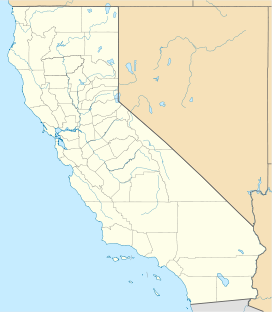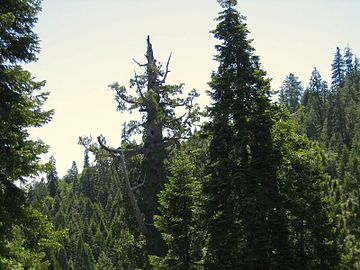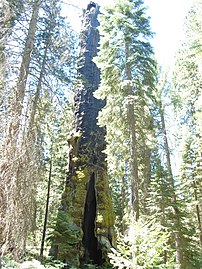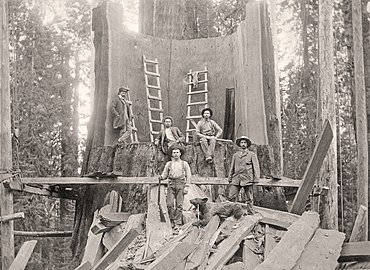Converse Basin Grove
| Converse Basin Grove | |
|---|---|
 A steam donkey crew at the Boole Tree, 1894. | |
| Map | |
| Geography | |
| Location | Fresno County, California, United States |
| Coordinates | 36°48′00″N 118°58′00″W / 36.8°N 118.966667°W |
| Elevation | 5,900–6,600 ft (1,800–2,000 m) |
| Area | 4,666 acres (18.88 km2) |
| Ecology | |
| Dominant tree species | Sequoiadendron giganteum |
Converse Basin Grove is a grove of giant sequoia (Sequoiadendron giganteum) trees in the Giant Sequoia National Monument in the Sierra Nevada, in Fresno County, California,[1] 5 miles (8 km) north of General Grant Grove, just outside Kings Canyon National Park.[1] Once home to the largest population of giant sequoias in the world, covering 4,600 acres (19 km2) acres,[2]: 138 the grove was extensively logged by the Sanger Lumber Company at the turn of the 20th century. The clearcutting of 8,000 giant sequoias, many of which were over 2,000 years old, resulted in the destruction of the old-growth forest ecosystem.[3]
The Converse Basin Grove has not recovered despite attempts at restoration in the 20th century. The planting of single-species conifer plantations and the practice of fire exclusion has resulted in two high intensity wildfires since the end of the logging era, further degrading the giant sequoia habitat.[4] Despite these challenges, the grove offers opportunities for studying forest resilience and restoration efforts.[2]: 36, 45
Converse Basin Grove is home to several notable giant sequoia trees, including the Boole Tree, the sixth largest of its kind in the world, and the Chicago Stump, the remains of the General Noble Tree which was cut down for the 1893 World's Columbian Exposition. Another notable tree in the grove is the Muir Snag, which is believed to have been 3,500 years old at the time of its death, making it one of the oldest known giant sequoias.[5]
History
[edit]Eponym
[edit]Converse Basin was named after Charles Porter Converse. Converse was a founder of the Kings River Lumber Company and had planned to log the area in the 1860s.[6][7] However, an economic recession interrupted Converse's plans. He left the company shortly after its founding.[8]: 55–56
Logging Era
[edit]
Converse Basin was once the world's second-largest giant sequoia grove before it was logged of most of its giant sequoias between 1892–1918. The Kings River Lumber Company was refinanced as the Sanger Lumber Company and began logging the grove. They engaged in destructive clearcutting practices, cutting down 8,000 giant sequoias in a decade-long event that has been described as "the greatest orgy of destructive lumbering in the history of the world."[3] Only 60-100 large specimens survived.[1]
Conservation Movement
[edit]In the 1870s, the threat to Converse Basin motivated conservationists to take action. Colonel George W. Stewart, a newspaper publisher and editor, played a crucial role in linking local efforts to preserve giant sequoias to the national conservation movement. As a result, Sequoia, General Grant, and Yosemite National Parks were established in 1890.[9][10]: 24–29 However, federal protection for the Converse Basin Grove came too late. The area did not receive federal protected from logging until it was designated as part of Sequoia National Monument through a presidential proclamation by Bill Clinton in April 2000.[11][12]
Environmental Impact
[edit]The logging of giant sequoias in Converse Basin resulted in the collapse of the old-growth forest ecosystem needed to sustain them. In 1915, Henry Seidel Canby wrote evocatively of the destruction in Harper's Monthly.[13]
It lay, a great bowl, open and near the sky, views down from its southern rim to the great plain, an edge of forest cresting it to the north. All within was a vast and lonely cemetery. A stream wound among broken trunks, torn roots, and whitened slabs of lumber, through the midst of the grassy valley. Above the thin turf rose weathered pines or clumps of feathery sequoia, like Italian cypresses, and beneath and beside them, at decorous intervals, were the great tombs of the dead sequoia.
They were only stumps, but in that melancholy landscape stumps like these had power over the imagination. The bark had long since gone from them, but the wood held firm and fast. Ten feet, fifteen feet, twenty feet, they rose above the ground, and two of us could lie head-to-head upon the tops as we pored over their thousand years of rings.
Twenty years had brought back beauty to this wasted valley, though beauty of a strange and melancholy sort. Flowers were everywhere, most of all where the little stream at intervals drew over its ripples a canopy of pink azalea, now in fullest bloom. But the forest had gone. An indiscriminate slaughter had let in the sun, its enemy; had dried the springs, which were its lifeblood; and such tearing and ripping as we had seen at Hume had rendered the soil, its mother, unfit except for barren grass. A few lonely redwoods, spared out of wantonness, had done their best to plant the spaces, but the younglings near them could only patch the ground; the pines and firs had well-nigh given up the struggle. Ranging cattle were more than a match for Nature and her seedling trees. In the great stumps themselves, in blocks and fragments scattered over the soil, in the logs which choked the streams, was more dead and wasted lumber than a forester could hope to grow on so many acres in a hundred years. The story of the Appalachians was being told again, and more loudly.

In the 1930s, Sequoia National Park commissioner Walter Fry and superintendent John R. White, “marveled that man had been able by crude methods to do so much damage.”[10]: 20
Ecosystem Management
[edit]Converse Basin has not recovered over a century after it was overlogged. In an attempt to restore the forest, single-species conifer plantations were planted. However, these plantations have been unsuccessful and have caused more harm than good. They are prone to pine beetles and have disrupted the local water cycle, leading to an increase in dead trees and dense fuel loads. These conditions have increased the risk of wildfire.
Wildfire
[edit]
Two wildfires have occurred in Converse Basin since logging stopped in 1918. The first, the McGee Fire, burned all the young sequoias in Converse Basin and threatened the Boole Tree in 1955.[14] This event led to the realization of the dangers of suppressing fires and the benefits of prescribed burns. The second wildfire, the Rough Fire, occurred in 2015 and re-burned an area affected by the McGee Fire. However, no trees of exceptional size or historical significance were harmed.[4]
Hiking and Recreation
[edit]There are three main trails in Converse Grove: Boole Tree Trail, Chicago Stump Trail, and Stump Meadow.[5][15]
- The Boole Tree Trail is a moderate 2.5 miles (4.0 km) loop with restroom facilities but no drinkable water, offering views of the Kings River gorge and the Sierra Nevada mountains. The trail passes through a forest of white fir, oaks, incense cedar, and a few young sequoias.[15]
- The Chicago Stump Trail is an easy .5 miles (0.80 km) loop that winds through a meadow with young sequoias and leads to the remains of a tree called the Chicago Stump.[15]
- Stump Meadow is a meadow filled with sequoia stumps left over from historic logging and is surrounded by young sequoias that are about 100 years old. Scientists are studying why this area has not regenerated like the rest of the grove.[15]
Noteworthy trees
[edit]Some of the trees found in the grove that are worthy of special note are:
- Boole Tree: Before 1931, it was believed by some that the Boole Tree was the largest tree in the world, although the General Grant Tree was more widely recognized as the largest at that time. After comparing measurements of other trees, the Boole Tree was determined to be the 6th largest, with a volume of 42,472 cubic feet (1,202.7 m3). Despite this ranking, the Boole Tree is still remarkable, with a girth of over 112 feet (34 m)[15] at its base and a height of 267 feet (81 m). It is the largest giant sequoia on National Forest System lands.[2]: 12
- Chicago Stump: the remnant of the General Noble Tree which was cut for the 1893 World's Columbian Exposition. The General Noble Tree was the second-largest tree in the grove. Although not among the very largest giant sequoias, the General Noble Tree was perhaps among the top 30 largest giant sequoias before it was cut.
- Muir Snag: The Muir Snag is one of the largest and tallest standing dead trees in the world. It is believed to be over 3,200 years old when it died. It has a maximum base diameter of 35.9 feet (10.9 m). The tree is still standing but only at 140 feet (43 m) tall. Before it died, its perimeter could have been as much as 110 feet (34 m). The tree is named for naturalist John Muir who described the tree as "the largest I measured" in a report for Charles S. Sargent, the Harvard botanist.[16]
Gallery
[edit]-
Boole, the 6th largest giant sequoia in the world.
-
The dead canopy of Boole caused by shock immediately after almost all of the surrounding trees were cut down.
-
The Muir Snag
-
The General Noble Tree was cut, sectioned, and shipped to Chicago for the World Columbian Exposition.
-
The General Noble on display in Chicago in 1893.
See also
[edit]- List of giant sequoia groves
- Hume-Bennett Lumber Company
- Nelder Grove - a giant sequoia grove that was logged extensively in the 19th century.
Bibliography
[edit]- Fry, Walter; White, John R. (1930). Big Trees. Palo Alto, California: Stanford University Press.
- Hartesveldt, Richard J.; Harvey, H. Thomas; Shellhammer, Howard S.; Ronald E., Stecker (1975). The Giant Sequoia of the Sierra Nevada (PDF). Washington, D.C.: U.S. Department of the Interior, National Park Service.
- Johnston, Hank (2003). They Felled the Redwoods (Thirteenth ed.). Stauffer Publishing. ISBN 0-87046-003-X.
- McGee, Lizzie. Mills of the Sequoias, Visalia, California, Tulare County Historical Society, Historical Bulletin, March 1952
References
[edit]- ^ a b c "Converse Basin Grove". US Forest Service - Sequoia National Forest. Archived from the original on 2020-07-28. Retrieved 9 December 2019.
- ^ a b c "Giant Sequoia National Monument Management Plan" (PDF). USDA.gov. United States Department of Agriculture. August 2012. Retrieved January 4, 2023.
- ^ a b Zimmerman, Robert (Fall 1998). "Log Flume". American Heritage's Invention and Technology. American Heritage. Retrieved December 23, 2022.
- ^ a b "District Personnel Actively Managing Land burned in Rough Fire". USFS - Sequoia National Forest. March 2016. Archived from the original on 2016-06-14. Retrieved 9 December 2019.
- ^ a b "Converse Basin Grove". United States Forest Service. USDA. Retrieved January 5, 2023.
- ^ "King's River Rafting and Lumbering Franchise". Sacramento Daily Union. Sacramento, California. January 22, 1872. Retrieved December 25, 2022.
- ^ "City Intelligence". Sacramento Daily Union. Sacramento, California. January 19, 1876. Retrieved December 25, 2022.
There were filed yesterday in the office of the Secretary of State articles of incorporation of the King's River Lumbering Company, organized for the purpose of manufacturing lumber, posts and timber, etc., in the mountains of Fresno county. Capital, $100,000 in shares of $100 each. Directors — B. F. Scott, Jesse Morrow. William Helm, J. M. Gregory and Charles P. Converse. The principal place of business will be in the town of Fresno.
- ^ Johnston, Hank (2003). They Felled the Redwoods (13th ed.). Stauffer Publishing. ISBN 0-87046-003-X.
- ^ Farmer, Jared (2017). Trees in Paradise: A California History. Berkeley, California: Heyday Books. p. 44. ISBN 9780393078022.
- ^ a b Fry, Walter; White, John R. (1930). Big Trees. Palo Alto, California: Stanford University Press.
- ^ "Giant Sequoia National Monument". U.S. Forest Service. U.S. Department of Agriculture. 2 October 2015. Retrieved January 3, 2022.
- ^ "Proclamation 7295—Establishment of the Giant Sequoia National Monument". The American Presidency Project. UC Santa Barbara. April 15, 2000. Retrieved January 4, 2023.
No portion of the monument shall be considered to be suited for timber production, and no part of the monument shall be used in a calculation or provision of a sustained yield of timber from the Sequoia National Forest. Removal of trees, except for personal use fuel wood, from within the monument area may take place only if clearly needed for ecological restoration and maintenance or public safety.
- ^ Canby, Henry Seidel (June 1915). "The Last Stand of the Redwoods". Harper's Monthly Magazine. Vol. CXXXL. New York and London: Harper Brothers Publishers. p. 58. Retrieved December 23, 2022.
- ^ "Sierra Fire Leaps Lines, Hits Basin". Madera Tribune. Madera, California. September 9, 1955. Retrieved December 26, 2022.
- ^ a b c d e McKinney, John (April 21, 2002). "It's Clear-Cut: Converse Basin's Sequoias Were Once Majestic". Los Angeles Times. Retrieved January 5, 2023.
- ^ Limbaugh, Ron (1992). "Reflections on a Redwood Snag". John Muir Newsletter. The Sierra Club. Retrieved January 4, 2023.
It was burned half through. I cleared away the charred surface with an axe & tried hard to count the wood layers through a lens. The first five feet from the outside was clear & regular & in this distance there are 1672 layers but beyond this point toward the center the wood was so contorted & interrupted by wounds that I was unable to get a sure count, thought I made out upwards of 4000 layers.
External links
[edit] Media related to Converse Basin Grove at Wikimedia Commons
Media related to Converse Basin Grove at Wikimedia Commons







